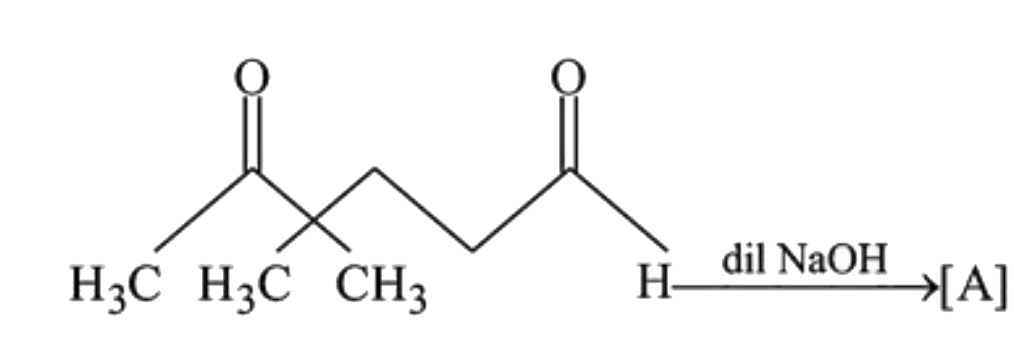(CH3)2CONaCN−−−→HCI(A)H+3O−−→Δ(B)
In the above sequence of reactions, (A) and (B) are :
(CH3)2C(OH)CN.(CH3)2C(OH)COOH
(CH3)2C(OH)CNH2.(CH3)2C(OH)2
(CH3)2C(OH)CN.(CH3)2CHCOOH
(CH3)2C(OH)CNH2.(CH3)2C=0
The correct Answer is:A
To solve the given question, we will analyze the reaction step by step.
Step 1: Identify the starting compound
The starting compound is (CH₃)₂CO, which is acetone (a ketone). The structure of acetone is:
O
||
CH₃-C-CH₃
Step 2: Nucleophilic attack by CN⁻
In the presence of NaCN, the cyanide ion (CN⁻) acts as a nucleophile. The carbonyl carbon of acetone is electrophilic due to the partial positive charge on it. The CN⁻ ion attacks the carbonyl carbon, leading to the formation of a cyanohydrin.
The reaction can be represented as follows:
(CH₃)₂CO + CN⁻ → (CH₃)₂C(OH)(CN)
This product can be denoted as A:
A:(CH₃)₂C(OH)(CN)
Step 3: Protonation of the alkoxide
When the product A reacts with HCl, the alkoxide (O⁻) gets protonated:
(CH₃)₂C(OH)(CN) + H⁺ → (CH₃)₂C(OH)(CN)
This step does not change the structure of A but confirms that we have a hydroxyl group and a cyanide group attached to the same carbon.
Step 4: Hydrolysis of the cyanide group
Now, when product A undergoes hydrolysis in the presence of heat (Δ), the CN group is converted into a carboxylic acid (COOH). This reaction can be represented as:
(CH₃)₂C(OH)(CN)+H₂O→(CH₃)₂C(OH)(COOH)
This product can be denoted as B:
B:(CH₃)₂C(COOH)(OH)
Final Products
Thus, the final products are:
- (A) = (CH₃)₂C(OH)(CN)
- (B) = (CH₃)₂C(COOH)(OH)
Summary of Products
- A: (CH₃)₂C(OH)(CN)
- B: (CH₃)₂C(COOH)(OH)
The starting compound is (CH₃)₂CO, which is acetone (a ketone). The structure of acetone is:
O
||
CH₃-C-CH₃
In the presence of NaCN, the cyanide ion (CN⁻) acts as a nucleophile. The carbonyl carbon of acetone is electrophilic due to the partial positive charge on it. The CN⁻ ion attacks the carbonyl carbon, leading to the formation of a cyanohydrin.
(CH₃)₂CO + CN⁻ → (CH₃)₂C(OH)(CN)
This product can be denoted as A:
A:(CH₃)₂C(OH)(CN)
When the product A reacts with HCl, the alkoxide (O⁻) gets protonated:
(CH₃)₂C(OH)(CN) + H⁺ → (CH₃)₂C(OH)(CN)
This step does not change the structure of A but confirms that we have a hydroxyl group and a cyanide group attached to the same carbon.
Now, when product A undergoes hydrolysis in the presence of heat (Δ), the CN group is converted into a carboxylic acid (COOH). This reaction can be represented as:
(CH₃)₂C(OH)(CN)+H₂O→(CH₃)₂C(OH)(COOH)
This product can be denoted as B:
B:(CH₃)₂C(COOH)(OH)
Thus, the final products are:
- (A) = (CH₃)₂C(OH)(CN)
- (B) = (CH₃)₂C(COOH)(OH)
- A: (CH₃)₂C(OH)(CN)
- B: (CH₃)₂C(COOH)(OH)
Topper's Solved these Questions
- ALDEHYDES, KETONES AND CARBOXYLIC ACIDS BOOK - AAKASH INSTITUTE ENGLISHCHAPTER - ALDEHYDES, KETONES AND CARBOXYLIC ACIDS EXERCISE - Assignment (SECTION -B OBJECTIVE TYPES QUESTIONS (ONE OPTION IS CORRECT)
24 Videos
- ALDEHYDES, KETONES AND CARBOXYLIC ACIDS BOOK - AAKASH INSTITUTE ENGLISHCHAPTER - ALDEHYDES, KETONES AND CARBOXYLIC ACIDS EXERCISE - Assignment (SECTION -C Objective type questions more than one options are correct)
11 Videos
- ALDEHYDES, KETONES AND CARBOXYLIC ACIDS BOOK - AAKASH INSTITUTE ENGLISHCHAPTER - ALDEHYDES, KETONES AND CARBOXYLIC ACIDS EXERCISE - Illustrations
3 Videos
- ALCOHOLS, PHENOLS AND ETHERS BOOK - AAKASH INSTITUTE ENGLISHCHAPTER - ALCOHOLS, PHENOLS AND ETHERS EXERCISE - Try Yourself
5 Videos
- AMINES BOOK - AAKASH INSTITUTE ENGLISHCHAPTER - AMINES EXERCISE - Assignment Section -J (Aakash Challengers Questions)
9 Videos
Similar Questions
Knowledge Check
CH3−CH=CH2Br2−−−−−−−−→h v (low conc.)Mg−−−−−→Dry etherCH3−O∣∣C−CH3−−−−−−−−−→NH4ClH+−−→Δ(X)(major)
End product (X) of the above reaction is :ACH2=CH−CH2−CH2∣∣C−CH3BH2C=CH−CH=C∣CH3−CH3CH2C=CH−CH2−OH∣C∣CH3−CH3DH2C=CH−CH2−CH−CH2∣CH3−OHPh−O∣∣C−CH3NaNO2−−−−→HCl(A)AC2O−−→heat(B)H3O+−−−→(C)
Product ( C) of the above reaction is :APh−CO2HBPh−O∣∣C−CO2HCPh−O∣∣C−O∣∣C−HDPh−O∣∣C−CH2OH
(CH3)2CHOHMild−−−−−−→oxidation[O](X)(i)CH3Mgl−−−−−−−−→(ii)Hydrolysis(Y)
In the above sequence of reaction, (Y) is:
View SolutionCH3−C≡CHLinddar's−−−−→catalyst(A)ConcH2SO4−−−−−−→H2O(B)
What are the products (A) and (B) in the given reaction?
View SolutionIn the reaction sequence
CH3−O∣∣C−H−HCN−−−→.ΘOH(A)H2O/⊕H−−−−→Δ Product is/are :
View SolutionBut-1-ene(CH3COO)2Hg−−−−−−−−−→H3O?
The product in the above reaction is
View SolutionCH3−CH2−C∣∣O−NH2A−−→CH3−CH2−NH2
B−−→CH3−CH2−OH
In the above sequence A & B respectively are-
View Solution Hdil NaOH−−−−→[A]H2O+−−−→Δ[B]
Hdil NaOH−−−−→[A]H2O+−−−→Δ[B]
View Solution
